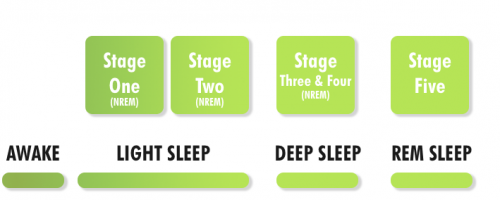The Different Stages of Sleep
Last updated on October 7th, 2022 at 10:29 am
During sleep your brain cycles through five different stages: 1, 2, 3, 4 and REM (rapid eye movement) sleep. A complete sleep cycle can take 90 to 110 minutes on average. You start with stage one, then make your way to REM and then you start the cycle from stage one again.
At the beginning of the night, you experience shorter REM sleeps and longer periods of deep sleep, however, later in the night, the REM sleep increases and the deep sleep time decreases.

Stage One
(NREM)
Stage 1 is the initial start of the sleeping cycle, this is where you slowly drift in and out of sleep and can be woken up easily. During the first stage, your body begins to relax, eyes move much slower and muscle activity decreases. It’s common for people to experience sudden painless muscle contractions, creating a sensation of falling.
Moving on to the next stage, it is important that your neck and shoulders are relaxed and appropriately supported. If your neck is elevated, it could increase the chances of experiencing a disrupted sleep.
Stage Two
(NREM)
During the second stage, your body is still completely relaxed and your eye movements stop while your brain waves become significantly slower with occasional bursts of waves. It is still very easy to be woken during this period, most people who take short naps would only reach this far in the cycle.
Stage Three
(NREM)
When you enter stage 3, your brain has extremely slow waves called delta waves which are interspersed with smaller, faster waves.
Stage Four
(NREM)
In stage 4, the brain produces delta waves almost exclusively. Stages 3 and 4 are commonly referred to as deep sleep or delta sleep, and it is very difficult to wake someone from them. In deep sleep, there is no eye movement or muscle activity. This is when some children experience bedwetting, sleepwalking or night terrors.
Random Fact:
In 2008 the sleep profession in the US eliminated the use of stage 4. Stages 3 and 4 are now considered stage 3.
Stage Five
(REM SLEEP)
Slow brain wave sleep happens mostly in the first period of the night, REM is the second half. If you are woken up during REM sleep, you may remember it the next morning. Short awakenings may disappear or be partially memorable with amnesia.
During REM sleep, your breathing becomes more rapid, irregular, your eyes move rapidly and your muscles are temporarily paralyzed. Your brain waves will also increase during REM sleep, much like what you experience when you’re awake. Alongside these, your heart rate increases, your blood pressure rises. This is the time when most dreams occur. If woken during REM sleep, a person can remember the dreams. Most people experience three to five intervals of REM sleep each night!
Depending on your age, REM sleep makes up around 20-25% of the average adult’s time asleep, which is experimentally 90-120 minutes.
Random Fact:
Infants spend almost 50% of their time in REM sleep. Adults spend nearly half of sleep time in stage 2, about 20% in REM and the other 30% is divided between the other three stages. Older adults spend progressively less time in REM sleep. Because your sleep cycle repeats, you enter REM sleep several times during the night.
Throughout REM sleep, your brain and body have energy and is typically where dreaming occurs. REM is thought to be connected with the process of storing your memories, learning and balancing your mood, but this is not 100% understood! Although some of the signals sent to the cortex during sleep are important for learning and memory, some could be random. These random signals that occur may for the basis for a “story” that the brain tries to understand, resulting in dreaming.
Why Memory Foam Pillows?
Having a supportive mattress topper and a supportive memory foam pillow can completely change the way that you sleep. Being supported helps to relieve pressure points in your neck & spine. If you are using an unsupportive pillow during sleep, it could cause a series of pains, including neck aches & backache.
When you’re supported and comfortable during the night, it significantly decreases disruption of sleep throughout the night, making for a much more rejuvenating night sleep.
